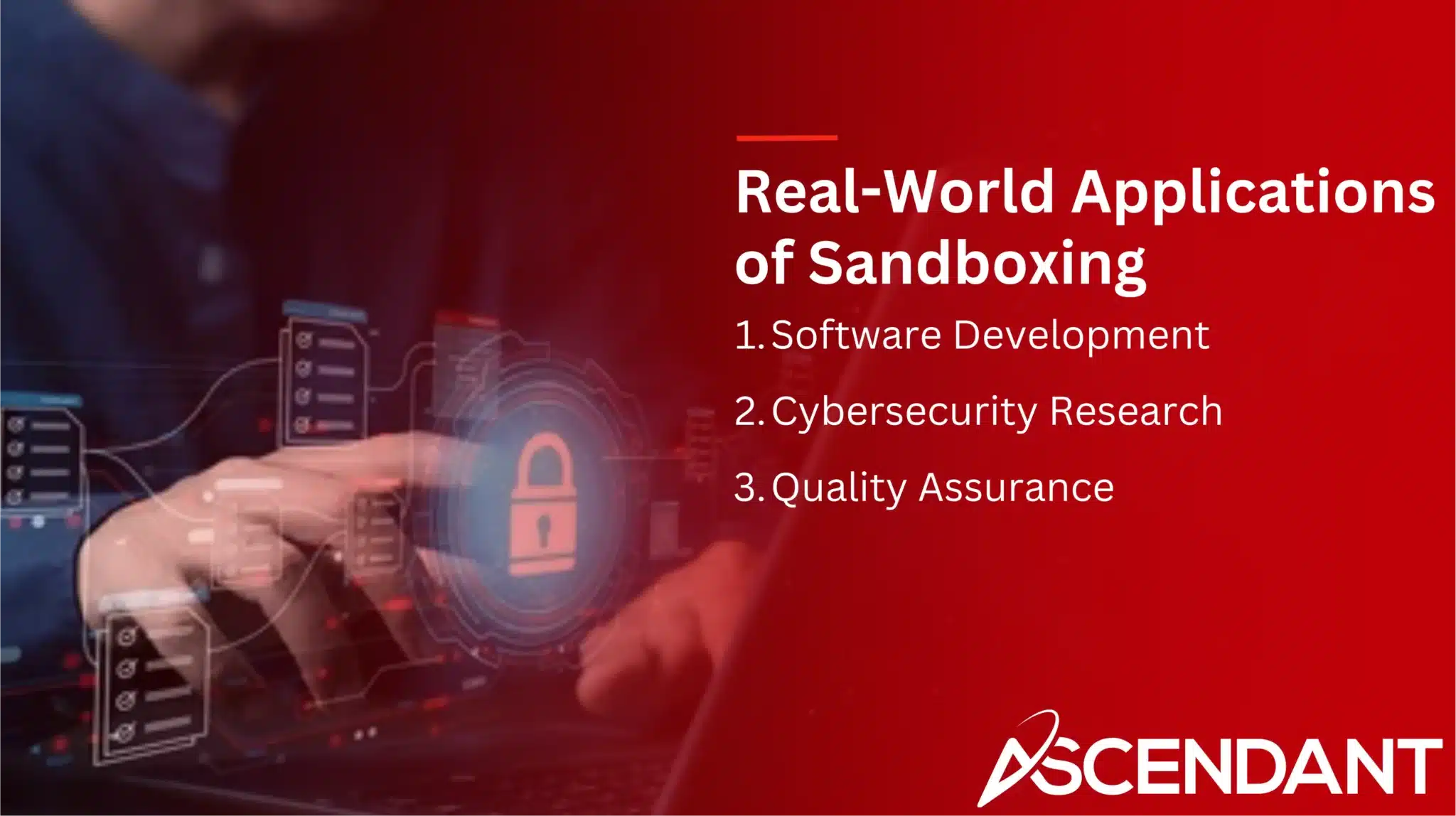Sandboxing is a method used in cybersecurity to run software in a separate, isolated environment to avoid risks to the main system. This article explains what is sandboxing, its benefits, and best practices for using it.
Key Takeaways
- Sandboxing creates isolated environments for safely testing software, enhancing cybersecurity by containing potential threats.
- Key benefits of sandboxing include improved security against zero-day vulnerabilities, a safe environment for software testing, and enhanced threat detection capabilities.
- Various sandboxing methods such as cloud-based, appliance-based, and hybrid solutions cater to organizational needs while addressing challenges like performance overheads and malware evasion techniques.
Understanding Sandboxing
Sandbox mode is a security measure that establishes a separate and secure environment within an operating system to test and examine software without endangering the principal system. It’s comparable to creating a safe, confined space where tests can be safely performed. The main objective of utilizing sandbox mode is to shield the core operating system or network from potential risks posed by untrusted software.
In practice, sandboxing involves setting up a virtual environment that closely replicates the primary system while functioning autonomously in this protected mode. This setup permits cybersecurity professionals to scrutinize software behavior within this safeguarded context, ensuring any harmful activity remains isolated and does not affect the broader system.
To understand what encompasses a sandbox and its role better: it’s crucial for managing risk by offering an insulated testing ground for new or suspicious programs before they interact with critical parts of our digital infrastructure.
What is a Sandbox?
A sandbox serves as a secure testing ground, allowing for the examination of programs and files in a way that doesn’t compromise the integrity of the principal system. This isolated environment enables safe execution and scrutiny of software.
Within cybersecurity circles, sandboxes are crucial tools for assessing software that may be potentially malicious. By quarantining dubious applications inside a sandbox, cybersecurity experts can monitor their actions to ascertain whether they present any danger. Not only does this technique protect the main system from potential threats, but it also helps professionals grasp the mechanics behind malicious code’s functionality.
How Sandboxing Works
Sandboxing operates on the principles of separation and monitoring. Software executing within a sandbox environment functions within an isolated virtual machine that reflects the principal system’s attributes while maintaining autonomy. This structure facilitates researchers in performing static and dynamic examinations, enabling them to study software activities without endangering the central network or hardware.
Contained exclusively inside this secure sandbox, any harmful actions are confined. Following the conclusion of these sessions, resetting the environment ensures removal of all potential dangers. The integration of such seclusion with comprehensive scrutiny offers a formidable shield against prospective cyber threats.
Key Benefits of Sandboxing
Sandboxing offers numerous benefits in the realm of cybersecurity, including:
- Bolstering protection through the segregation of software that could be potentially malicious.
- Facilitating a secure environment where new applications and updates can be examined without risk.
- Elevating the capability to spot threats by scrutinizing suspicious files within an environment designed for control.
For entities seeking to strengthen their cyber defenses, sandboxing has emerged as an essential strategy.
Now, let’s delve into each of these advantages more deeply.
Enhanced Security
One of the most significant benefits of sandboxing is its ability to enhance security by protecting against zero-day threats. These are vulnerabilities that have not yet been discovered or patched by developers. Isolating and examining untrusted code within a sandbox helps organizations prevent these threats from exploiting unknown vulnerabilities.
Advanced malware often employs techniques to evade detection, but innovative sandboxing solutions now incorporate multi-engine analysis to improve detection rates. Regular updates and maintenance of sandbox environments are crucial to keep up with evolving threats and ensure continued protection.
Safe Testing Environment
The concept of sandboxing is pivotal in contemporary software development, as it establishes a controlled environment where software can be tested securely. Within the confines of a sandbox, companies have the capacity to scrutinize programs and evaluate security threats with no jeopardy to active systems.
As an invaluable asset for quality assurance efforts, this protected testing arena enables teams to execute exhaustive tests and pinpoint potential weaknesses before launching software into operational settings. By forestalling interruptions within live environments, sandboxes play a crucial role in facilitating dependable and safeguarded releases of software applications.
Improved Threat Detection
Sandboxing serves as a preventive measure against numerous online threats, providing cybersecurity experts with an isolated environment to evaluate suspicious files. This method is essential for the analysis of malware because it permits professionals to scrutinize the actions of potentially malicious software while safeguarding the primary system.
Advancements in sandbox technology are boosting threat detection efficiency by replicating actual attack environments and employing artificial intelligence along with machine learning techniques for pattern recognition. These enhancements assist businesses in predicting and defending against prospective attacks more adeptly.
Types of Sandboxing Methods
There are multiple methods to execute sandboxing, each with its own set of advantages. The main variations encompass cloud-based, appliance-based, and hybrid sandboxing solutions, tailored to meet the diverse needs and security specifications of organizations.
To fully grasp their unique strengths, it’s important to explore these approaches in detail.
Cloud-based Sandboxing
Organizations can conduct testing within a secure, isolated environment using cloud-based sandboxing to avoid endangering their own systems. The beauty of this approach is that it doesn’t require automation and is manageable by any member of an IT team. By keeping untrusted code contained in a virtual environment, such sandboxing acts as a barrier against illicit access to confidential data.
This method provides both adaptability and scalability in safeguarding against advanced malware and zero-day threats, making it an invaluable tool for protecting sensitive environments from unauthorized code execution or system compromise.
Appliance-based Sandboxing
The use of appliance-based sandboxing entails employing in-house hardware, like a host machine, for the purpose of evaluating applications while shielding the system from potential threats. By doing so, it permits the scrutiny of questionable files within a safe and separate environment to greatly reduce any risk of harming the local network.
Scrutinizing SSL traffic with great care is crucial to thwart malware that might hide within encrypted connections. Offering substantial security measures, appliance-based sandboxing serves as an effective defense mechanism particularly suited for organizations inclined towards on-premises solutions.
Hybrid Sandboxing
Hybrid sandboxing integrates the benefits of cloud-based strategies with those of appliance-based techniques to deliver a solution that is both flexible and secure. This fusion garners an all-encompassing approach capable of adjusting to diverse security requirements and settings.
By embracing this methodology, organizations can capitalize on the expansive scalability afforded by cloud sandboxing while preserving the command characteristic of appliance-centric approaches, culminating in an intensified safeguard against digital threats.
Implementing Sandboxing in Your Organization
Incorporating sandboxing into the security infrastructure of an organization is vital to add an extra layer of defense against new and evolving threats. By establishing a virtual environment and melding it with current security measures, the deployment of sandboxing can greatly improve the defensive stance of an organization.
We will examine the processes required to achieve this implementation.
Setting Up a Virtual Environment
Configuring a virtual machine with an installed operating system in an isolated environment is the usual approach to creating a sandbox. It’s crucial to allocate suitable hardware resources, including memory, CPU, and storage, for optimal functioning of this virtual setup.
In order to analyze and test potential security threats without risking the primary system, cybersecurity professionals employ this sandbox. By doing so, they make sure that any malicious activities remain confined within this controlled environment.
Integrating with Existing Security Tools
Incorporating sandbox environments into network protection mechanisms enables the scrutiny of files and emails that enter a system to detect any potentially malicious activities. The adoption of sandboxes as a component within a comprehensive defense approach can greatly improve an organization’s ability to identify threats.
It is critical to overcome integration challenges and compatibility obstacles with current security infrastructures in order to achieve uninterrupted operation and maintain complete network coverage. Sandboxes provide an environment for testing API integrations, allowing developers to assess new APIs without affecting live systems.
Best Practices for Maintenance
Maintaining effective sandbox environments requires strategies for efficient resource management to prevent performance bottlenecks. Regular updates and monitoring are essential to ensure that sandboxing environments remain effective against evolving threats.
By isolating and diagnosing software issues within a controlled space, organizations can troubleshoot effectively without affecting the main system.
Real-World Applications of Sandboxing
Sandboxing serves as a versatile tool applied in numerous domains, offering a secure and regulated environment for experimentation and scrutiny. This practice spans from software development to cybersecurity exploration and ensuring the quality of software products.
We will delve into the diverse and significant uses of sandboxing across these fields.
Software Development
Within the realm of software development, an isolated environment known as a sandbox is employed to scrutinize new software and code. This approach safeguards stable versions from disruption by untested applications or code changes. It enables developers to detect glitches and verify that their new creations operate correctly without jeopardizing the integrity of the production environment.
Sandboxes create a secure setting which plays a crucial role in reducing security risks while confirming dependable deployment of software updates.
Cybersecurity Research
Cybersecurity experts employ sandboxing environments to safely run and scrutinize malicious code. These controlled settings enable them to examine isolated threats, discern behavioral patterns, and create tangible indicators of compromise (IOCs). Certain malware is designed with the capability to recognize these sandboxing environments and thwart execution, which makes analysis more difficult.
Even with such hurdles in place, utilizing sandboxing continues to be an essential strategy for grasping and mitigating advanced cybersecurity threats.
Quality Assurance
Quality assurance employs sandboxing to quarantine potential issues within code, enabling the safeguarding of current functions against negative impacts from software updates. The utilization of a staging server is commonplace for executing quality assurance assessments on code prior to its release into the live environment.
Through this method, entities can pinpoint and rectify problems within a meticulously controlled environment, guaranteeing that software rollouts are both dependable and secure.
Challenges and Limitations of Sandboxing
Organizations need to recognize that although there are many advantages to sandboxing, it is accompanied by various obstacles and constraints. These include performance overheads, methods of evasion, and issues with integration. Being mindful of these challenges is essential for the effective use of sandboxing within cybersecurity strategies.
Performance Overheads
The process of sandboxing may exert considerable strain on system resources, given its reliance on segregating and supervising activities within the environment. It is critical to strike a balance between safeguarding performance and maximizing security so that system resources are not overly consumed while still maintaining robust protection.
After concluding a session in the sandbox, all applications or files that were executed inside this controlled space get eliminated. This practice serves to limit potential threats and helps liberate system resources for other uses.
Evasion Techniques
Advanced malware utilizes various tactics to circumvent discovery by sandbox technologies. For example, certain types of malicious code can determine whether they are operating within a sandbox environment and delay unleashing their harmful payload accordingly. Polymorphic malware changes its code on an ongoing basis in order to elude recognition, while some manage to hide within SSL traffic. These methods present substantial hurdles for appliance-based sandboxes when it comes to identifying potentially malicious code.
To effectively combat these evasion strategies, it is critical that detection mechanisms remain strong and are regularly updated.
Integration Issues
Incorporating sandboxing solutions into current security setups can pose substantial technical challenges. Issues such as compatibility and the demand for more resources can make blending sandboxing with established security structures a complex task.
To tackle these obstacles, meticulous planning and coordination are essential to achieve smooth integration and to provide robust defense against potential threats.
Future Trends in Sandboxing
As organizations continue to embrace cloud-based infrastructures, sandboxing technology is evolving with trends pointing towards solutions that are both scalable and flexible. Future advancements in this area look set to boost the role of sandboxing in cybersecurity through incorporation of AI and machine learning, improved threat detection capabilities, and support for cross-platform applications.
AI and Machine Learning
By harnessing AI advancements, sandbox environments become more dynamic and robust in mitigating new threats. These sandboxes leverage AI to streamline threat response automation, thereby diminishing the necessity for immediate human action.
The application of machine learning algorithms within these environments allows for a meticulous examination of file and application behaviors. This enhances the ability to identify risks and counteract advanced threats that deploy evasion strategies effectively.
Advanced Threat Detection
In a controlled environment, sandboxing serves as an additional layer of defense against sophisticated malware and zero-day threats. Security teams utilize this technique to scrutinize suspicious files and the behavior of code, thereby augmenting their ability to detect threats.
Leveraging artificial intelligence and machine learning enriches this methodology by accelerating precise recognition of potential dangers. Adopting such proactive strategies is crucial for preemptively safeguarding against upcoming attacks, solidifying the foundations of cybersecurity measures.
Cross-Platform Sandboxing
Sandboxing on a cross-platform basis provides applications the capability to operate within segregated environments among diverse operating systems, boosting both their security and dependability. This methodology offers uniform protection throughout multiple applications and systems, essential for upholding a steady stance in security. Nevertheless, it is imperative to resolve hurdles like compatibility difficulties and additional performance costs in order to realize smooth integration.
Going forward, the evolution of cross-platform sandboxing is expected to see greater incorporation with sophisticated technologies such as artificial intelligence. This will enhance its ability not only to recognize threats but also to adjust swiftly to emerging dangers.
Summary
Sandboxing environments are an essential component in cybersecurity, offering a controlled environment to safely examine and test software that could be malicious. Through the isolation of potential threats and improved detection capabilities, sandboxing is instrumental in safeguarding systems against sophisticated malware and vulnerabilities such as zero-day exploits. Sandboxing can take various forms—cloud-based, appliance-based, or hybrid—to accommodate distinct security requirements.
As advancements in technology continue to unfold, so does the progression of sandboxing environments’ capacities. Anticipate enhanced threat identification and quicker response times as artificial intelligence (AI) and machine learning become increasingly integrated into these systems. Uniform safety across different platforms will be achievable through cross-platform sandboxing strategies. To ensure comprehensive protection from nascent cyber dangers continually emerging on the horizon, it’s crucial for organizations to stay abreast of these developments while adhering to established best practices within their security frameworks.
 Frequently Asked Questions
Frequently Asked Questions
What is a sandbox in cybersecurity?
A sandbox in cybersecurity is an isolated environment that enables the testing and analysis of potentially harmful software without jeopardizing the primary system.
This controlled setting allows for the observation of suspicious code behavior.
How does sandboxing improve threat detection?
Sandboxing significantly improves threat detection by enabling the analysis of suspicious files and code in a controlled environment, effectively identifying and mitigating potential threats before they affect the primary system.
What are the benefits of cloud-based sandboxing?
Utilizing cloud-based sandboxing offers considerable advantages, including improved scalability and flexibility. This allows entities to execute secure evaluations in segregated environments, ensuring their local systems remain uncompromised.
This approach safeguards confidential data while offering protection from zero-day threats.
What challenges are associated with sandboxing?
Sandboxing presents challenges such as performance overheads, evasion techniques employed by advanced malware, and integration difficulties with existing security frameworks.
To effectively overcome these challenges, careful planning and ongoing updates are essential.
What future trends can we expect in sandboxing technology?
You can expect future trends in sandboxing technology to focus on integrating AI and machine learning for improved threat detection and response, alongside advancements in cross-platform solutions for consistent protection across various operating systems.



